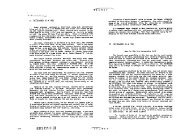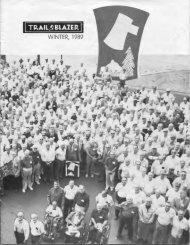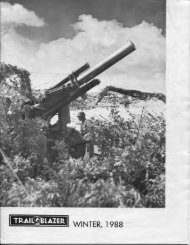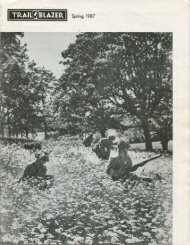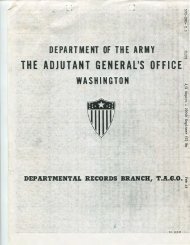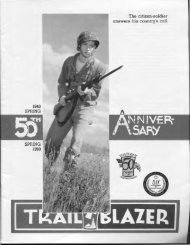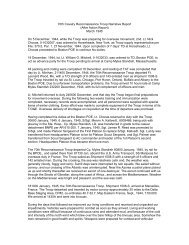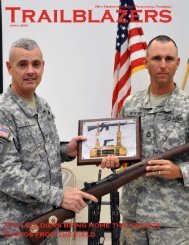Download - 70th Infantry Division Association
Download - 70th Infantry Division Association
Download - 70th Infantry Division Association
You also want an ePaper? Increase the reach of your titles
YUMPU automatically turns print PDFs into web optimized ePapers that Google loves.
As of this date, replacements required for the regiment were listed at six officers and 281 enlisted men.<br />
There were 23 evacuations during the period covered in the report. Rations for three days and gas and oil<br />
for one day were on hand. There had been no ammunition expenditures listed for the period. The regiment<br />
was short four 1/4-T vehicles, 31 1-1/2-T, one 2 1/2-T and six 1/4-T trailers.<br />
On January 7, 1945 we launched an attack east of Lichtenberg France at 9:00. We advanced 2,000 yards<br />
and encountered no enemy We marched by foot at 1500 to Zinswiller, France, and arrived at<br />
2130, a distance of approximately 5 miles. Now, 2130 is late at night and I remember as we traveled<br />
along the road somebody gave the command "lock and load". While we marched, we had no rounds in<br />
our rifles; but when the command came down the line to "lock and load", everybody put a clip in their rifle.<br />
I don't know if you can imagine 190 men loading and locking heir rifles, but I would imagine half of them<br />
never did lock their rifles. If you just took your rifle by the barrel and jammed it on the ground quick, the<br />
safety would go off. And if you can imagine the fear of the trigger-happy Americans (every bush, every<br />
rock, every shadow or silhouette. was a 6'10" German) that order never should have been given.<br />
Somewhere along that column, after the order of "lock and load" was given, we halted for one reason or<br />
another; They must have seen something and they were being cautious. When we stopped, we laid down<br />
on the side of the road again in the ditches. One guy started to shoot and pretty soon the whole company<br />
was shooting. It took the officers twenty minutes to get the thing stopped. Shooting at everything, we must<br />
have killed sheep, cows, shot windows out of houses. I don't know what we were shooting at and nobody<br />
else knew either.<br />
On January 8, 1945 at Zinswiller, France, we took 13 enlisted men to the hospital as casualties and<br />
probably half of them had trench feet. We had two pairs of socks with cotton toes and cotton heels and<br />
wool lining. We had shoe packs on that were made of leather to the top of the boot and rubber at the<br />
bottom of the boot. When you marched all day, your feet would sweat. We were not educated enough in<br />
the care of feet. We didn't understand that you had to take your feet out of those boots at night because<br />
your feet would chill and when they did chill they would freeze since the temperature was around zero<br />
and we were laying in the snow. With trench feet, your feet look like when you soak your hands in soapy<br />
water for a long time, all wrinkled. and white. So to avoid getting trench feet, we carried two pairs. of<br />
socks; one you wore and the other pair you would wrap around your belly. As you marched along during<br />
the day, the heat from your body would dry out your first pair of socks and then at night you changed<br />
socks. Maybe your socks weren't clean but at least they were dry. But, everybody got trench feet to some<br />
degree. My feet never got so bad that I had to leave the outfit. Some of the guys got so bad that they<br />
couldn't walk. Anyway, out of those 13 men, I would say 50% of them had trench feet and others were<br />
probably wounded in battle.<br />
The attack to be launched at 0700 9 January 1945 has as its objective the taking of four hills in the. area<br />
southwest of Baerehthal. Prior to the action, S-2 listed the enemy units in contact as 1st Battalion, 952nd<br />
Regiment, 361st <strong>Division</strong>, and 2nd Battalion, 476th Regiment, 256th <strong>Division</strong>. No reserves had been<br />
located. The enemy's activity consisted of defensive action in the regimental zone to include artillery fire<br />
throughout the area. Strength of the enemy at Obermuhlthal was estimated at one battalion of<br />
approximately 100 men. Morale of enemy troops was reported generally low.<br />
S-2 concluded that the enemy had three capabilities: To reinforce present positions and defend; to<br />
reinforce present positions with sufficient force to attack; to fight a delaying action on successive<br />
positions.<br />
The 1st and 2d Battalions jumped off at 0700 and the 3d Battalion at 0715, all advancing without<br />
opposition until about 1030. At that time Company C received sniper fire from Obermuhlthal, a town in the<br />
area of the 275th <strong>Infantry</strong>. Meanwhile, the 2d Battalion contacted the enemy in its sector.<br />
Informed that fire from Obermuhlthal was hampering the attainment of the lst Battalion's mission, G-3 said<br />
that the 275th <strong>Infantry</strong> on the right would aid in taking that town. On our left was the 313th <strong>Infantry</strong>.



